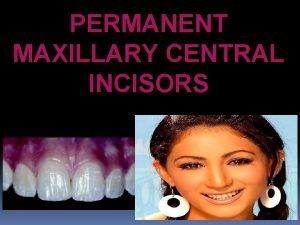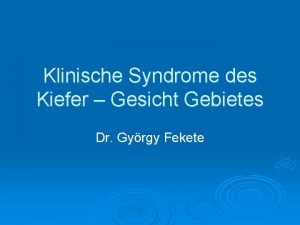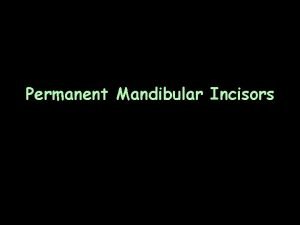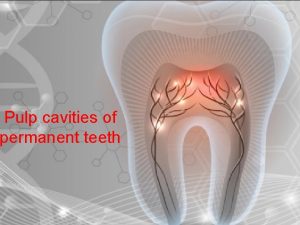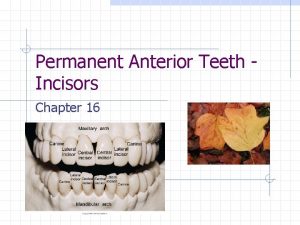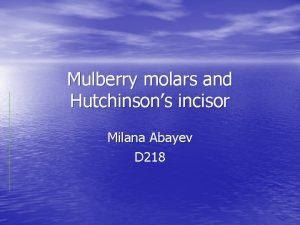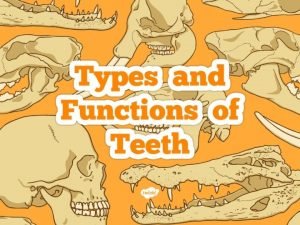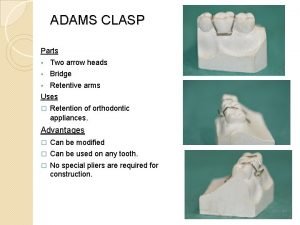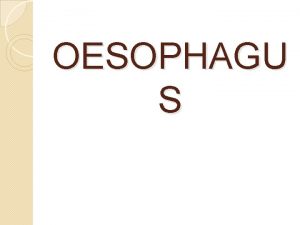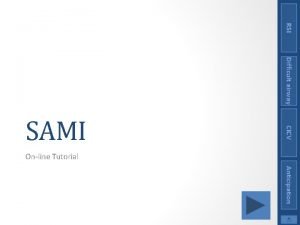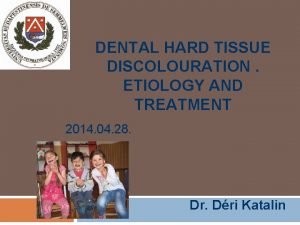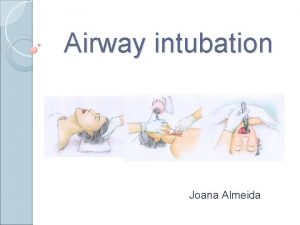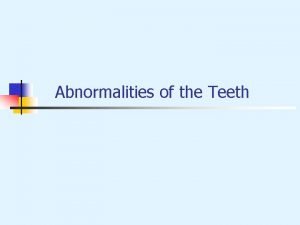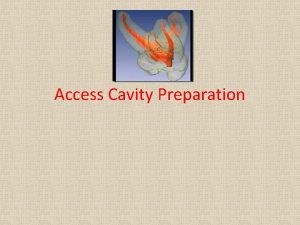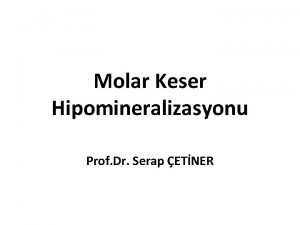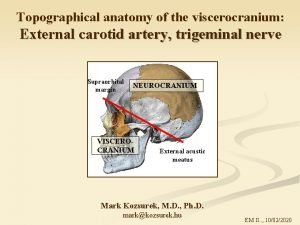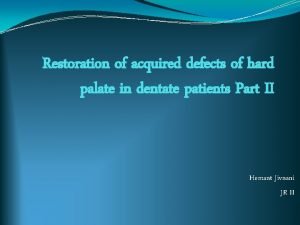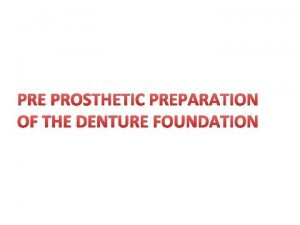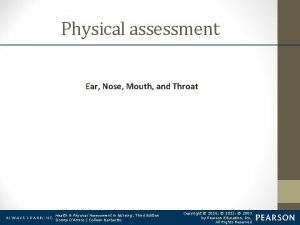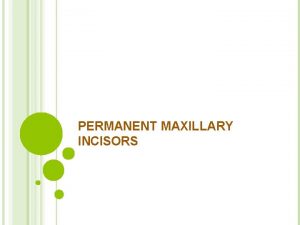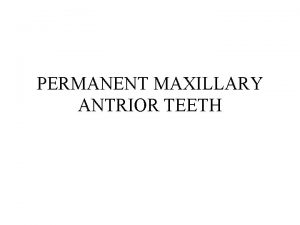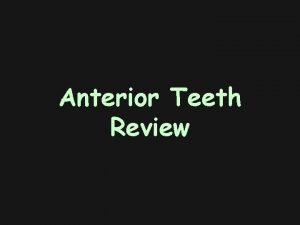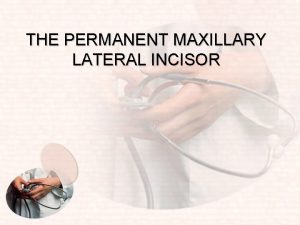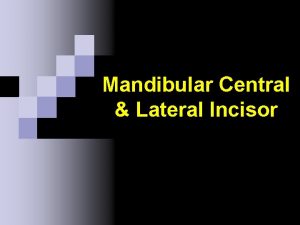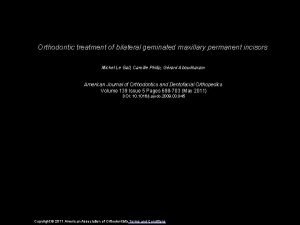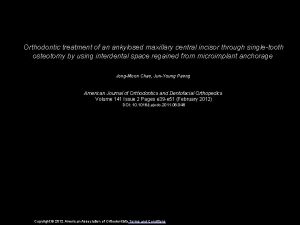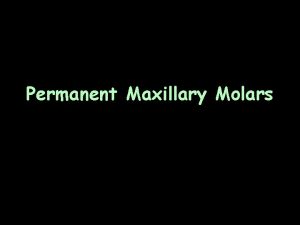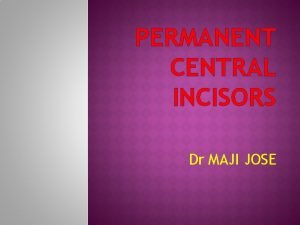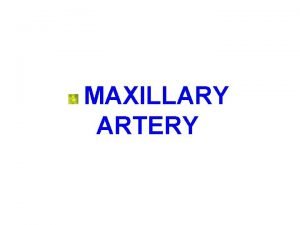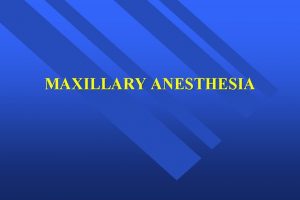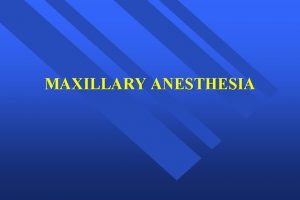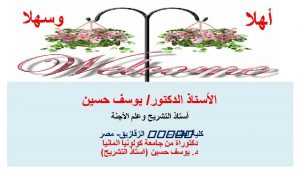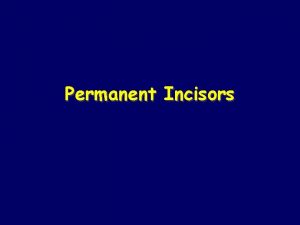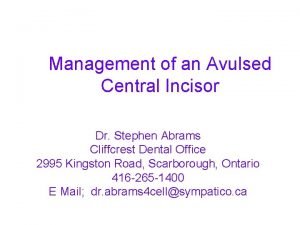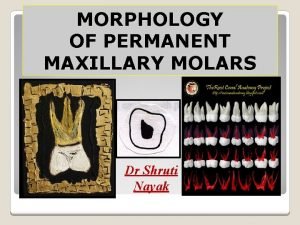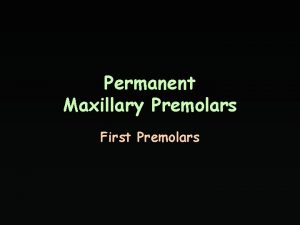Permanent Maxillary Central Incisor 1 INTRODUCTION Human incisors





















- Slides: 21

Permanent Maxillary Central Incisor 1

INTRODUCTION Human incisors have thin, blade -like crowns which are adapted for the cutting and shearing of food. There are two incisors per quadrant (four per arch) i. e. Central incisor and Lateral incisor. 2

INTRODUCTION contd. . Maxillary incisors arise in the premaxilla (which is merged into the maxilla in humans). Ø Most prominent tooth in the oral cavity. Ø Mandibular incisors are the teeth that articulate with them. Ø 3

Nomenclature FDI system- 11 - Maxillary right central incisor 21 - Maxillary left central incisor First evidence of calcification - 3 to 4 months Enamel completed - 4 to 5 years Eruption - 7 to 8 years Root completed - 10 years. 4

5

LABIAL / FACIAL ASPECT Geometrical form: the maxillary central incisor is quite regular in shape, forming a trapezoid Cervical line: shows an even semicircular curvature towards the root Mesial outline: it’s almost straight, with very slight curvature and the mesial line angle is longer than the distal line angle 6

LABIAL / FACIAL ASPECT Mesioincisal angle: it’s a sharp angle formed by the junction of the mesial and the incisal outline. It almost forms a right angle with the incisal edge. Distal outline: it’s more curved than the mesial outline Distoincisal angle: it’s a rounded angle formed by the junction of the distal and incisal outline 7

contd…. Mammelons are present on freshly erupted, unworn central incisors. The cervical line of crown follows a semicircular direction. Crest of curvature lies on the cervical third of the crown. The root is 2 -3 mm longer than crown and cone shaped with a relatively blunt apex. 8

LINGUAL ASPECT Geometrical form: trapezoid Cervical line: shows an even semicircular curvature towards the root Mesial outline: it’s almost straight, with very slight curvature Mesioincisal angle: it’s a sharp angle formed by the junction of the mesial and the incisal outline Distal outline: it’s more curved than the mesial outline Distoincisal angle: it’s a rounded angle formed by the junction of the distal and incisal outline 9

LINGUAL ASPECT contd… The incisal ridge is quite straight and slightly rounded at the angles Contact area mesially is in the incisal third close to the mesioincisal angle Contact area distally is more cervical than the mesial and its at the junction of the incisal and middle third The root has a parallel mesial and distal outline which then join ending in a blunt apex and the root has a conical form 10

LINGUAL ASPECT contd. . Important Anatomical Landmarks: Cingulum the bulge on the lingual surface of incisors or canines Marginal ridges are those rounded. borders of enamel which form the mesial and distal margins. Incisal ridge and the lingual fossa which is the irregular, rounded depression or concavity. A characteristic of the lingual surface is its convergence 11

MESIAL ASPECT Geometrical form: the proximal aspects are triangular in form with the cervical being the base of the triangle and the incisal edge being the apex Cervical line: shows an even semicircular curvature towards the incisal edge, and the cervical line mesially is more convex than distally Labial outline: extends with a very even slight curvature 12

MESIAL ASPECT contd. . Lingual outline: starts off with a convexity (that of the cingulum), then there is an area of concavity (that of the lingual fossa) and then it ends with a convexity again Crest of contour labially: is in the middle of the cervical third Crest of contour lingually: its also in the middle of the cervical third at the cingulum A characteristic of the proximal surface is that the incisal ridge is alligned on the same axis with the tip of the root 13

DISTAL ASPECT Geometrical form: the proximal aspects are triangular in form with the cervical being the base of the triangle and the incisal edge being the apex Cervical line: shows an even semicircular curvature towards the incisal edge, and the cervical line distally is less convex and less rounded than mesially Labial outline: extends with a very even slight curvature Lingual outline: starts off with a convexity (that of the cingulum), then there is an area of concavity (that of the lingual fossa) and then it ends with a convexity again 14

DISTAL ASPECT contd. . Crest of contour labially: is in the middle of the cervical third Crest of contour lingually: its also in the middle of the cervical third at the cingulum A characteristic of the proximal surface is that the incisal ridge is alligned on the same axis with the tip of the root One of the main differences between the mesial and distal aspects is the conact areas location 15

INCISAL ASPECT The crown from this view is broad and flat and wedge shaped The lingual convergence is very clear from this view, Mesial and distal profiles tapers lingually The labiolingual diameter is 1/3 times larger than the mesiodistal diameter 16

INCISAL ASPECT contd. . The incisal ridge is well observed in this view and it can be easily distinguished from the incisal edge The labial contour is almost flat with no depressions or elevations, it only shows a shift towards the distal side The lingual contour shows the cingulum very prominently from this view and also part of the fossa. And it shows how the cingulum is shifted distally 17

CONTACT POINTS The mesial contact point is just about at the incisal, owing to the very sharp mesial incisal angle. The distal contact point is located at the junction of the incisal third and the middle third. 18

MEASUREMENTS Cervico-incisal length of crown 10. 5 mm Length of root 13. 0 mm Mesio-distal diameter of crown 8. 5 mm Mesio-distal diameter of crown at cervix Labio-lingual diameter of crown 7. 0 mm Labio-lingual diameter of crown at cervix 6. 0 mm Curvature of cervical line- mesial 3. 5 mm Curvature of cervical line-distal 2. 5 mm 19

VARIATIONS The maxillary central incisor usually develops normally. Variations may include a short crown or, occasionally an unusually long crown. This tooth is rarely absent. The Hutchinson incisor is a malformation seen in congenital syphilis. An important variation of the upper incisors is the shovel shaped incisor presenting with large, robust marginal ridges and a deep lingual fossa. This feature is significant in Chinese, Eskimos, and North American Indians. 20

21
 Incisal ridge of central incisor
Incisal ridge of central incisor Hallermann-streiff-syndrom bilder
Hallermann-streiff-syndrom bilder Mount and hume classification
Mount and hume classification Permanent mandibular lateral incisor
Permanent mandibular lateral incisor Pulp
Pulp Central incisor line angles
Central incisor line angles Hutchinson incisors and mulberry molars
Hutchinson incisors and mulberry molars Functions of incisor teeth
Functions of incisor teeth Modified crib clasp
Modified crib clasp 25 cm from incisors
25 cm from incisors Incisor labiality
Incisor labiality Inter incisor gap
Inter incisor gap Amelogenesis imperfecta
Amelogenesis imperfecta Sniffing position for intubation
Sniffing position for intubation Inter incisor gap
Inter incisor gap Cleidocranial dysplasia
Cleidocranial dysplasia Mandibular molar access opening
Mandibular molar access opening Hipomineralizasyon
Hipomineralizasyon Lingual artery
Lingual artery Armany classification
Armany classification Bony undercut
Bony undercut Palpate frontal and maxillary sinuses
Palpate frontal and maxillary sinuses
